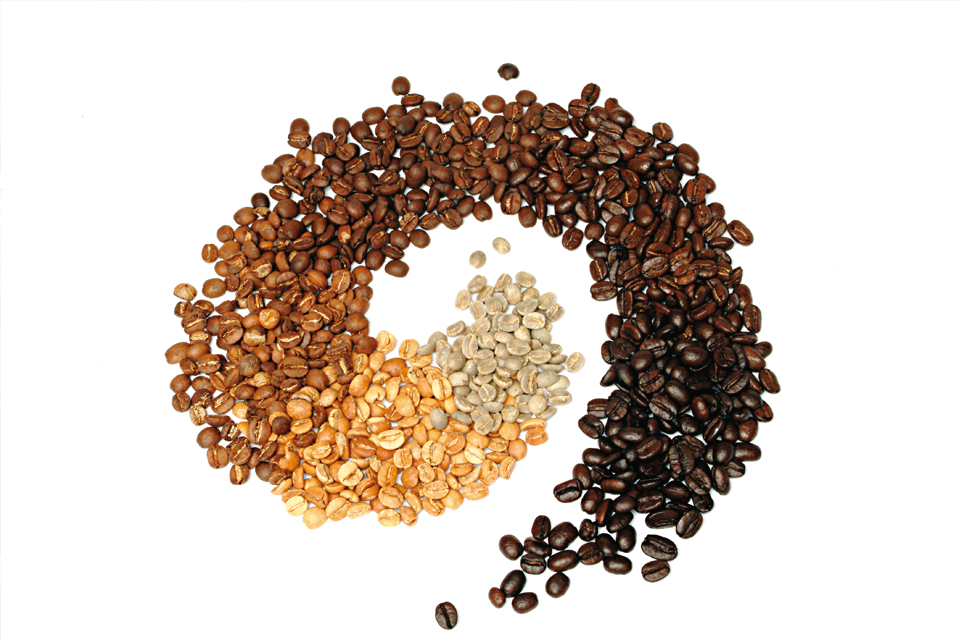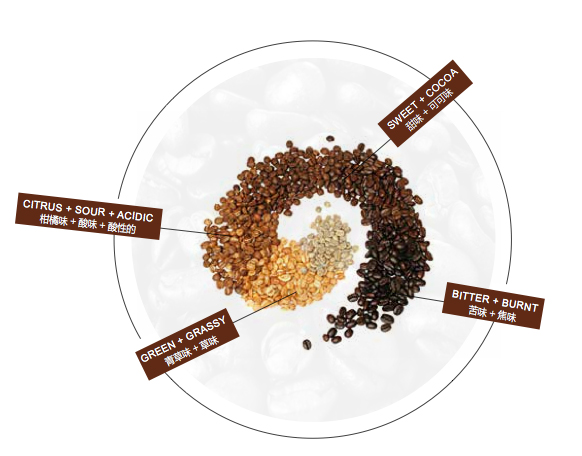Comparison of flavors between raw coffee beans and ripe beans
Sometimes, you'll see a lot of labels on the bean-cup scale that you haven't noticed before, such as almond pie, dried currants, green peaches, or cream. So, which of these unique flavors are inherent in coffee beans and which are presented through roasting?

Green coffee beans often have a "farm fragrance" like grass or hay, but if they are not properly preserved during storage and transportation, they can emit a musty, dusty, even wet cat food smell, and sometimes you can smell a fermented smell similar to a long-aged red wine cork. When you open the sack of raw beans on a good day, a sweet and ripe red fruit smell assaults your nose. As an aside, I am convinced that color can be perceived by smell. If you don't believe me, play some sensory Mini games, blindfold yourself, open a big bag of lollipops, and I bet you can tell the colors of most lollipops.
The bad odors mentioned above about coffee beans such as mildew or dust are mostly produced during planting, storage, packaging and transportation. Most of these odors will still be present after roasting. These flavors are masked or altered only in the case of extremely deep roasting.
Other flavors and aromas of coffee beans are innate, and we assume that all coffee fruits are picked at full maturity, so the aroma of coffee beans will be determined by the type of planting, the altitude of growth, the soil conditions, and the ecological environment.
When a coffee roaster wants to create a new blend, each coffee bean is considered an "ingredient," just like a chef selects spices on a cooking counter. Roasters are familiar with the characteristics of each bean and know exactly how they will affect the flavor of the new blend. Sometimes, the most significant contribution of a single bean to a blended coffee is not taste or aroma, but the tactile sensations it brings, such as body and taste. In different coffee blends, the main role of each individual bean will be different.
Continuing with the chef cooking example, the choice of different cooking levels will also affect the flavor of the ingredients. Onions, for example, are spicy, slightly spicy, bitter, sweet, caramelized, sizzling, burnt, and burnt after being cooked for different times and at different temperatures. We call it the onion's flavor wheel. Similarly, it is impossible to smell all the inherent flavors directly from raw coffee beans. Different flavors and aromas are reflected in different stages of coffee roasting, but they disappear with the deepening of roasting.
So, what flavor can a baker present in a born bean? I'm used to dividing it into eight stages, and of course there are more states in the middle of each stage, and the flavor presented will have all the characteristics of both stages.

But the most basic flavor is still shown in the above picture.
In the first half of the graph, the flavor is close to raw beans. Those beans that are not baked or baked for too short a time will take on the flavor of hay, wheat, straw or harvested straw. Next, we'll taste citric acid, which resembles lemon. As the baking time increases, a soft acidity will develop, similar to the taste of Australian green apples. After that, the sourness will become brighter and take on a red-wine-like acidity.
The second half of the graph is the coffee flavor that most people prefer. As coffee beans continue to roast deeper into the medium roast, sweetness will replace sourness as the dominant flavor. As the coffee beans turn brown, they develop a series of caramel flavors, followed by cocoa flavors, which is the threshold for optimal coffee body. As the roasting progresses, the bitterness masks the sweetness and becomes more pronounced, resembling dark chocolate with 80% cocoa content. If coffee beans are roasted for too long, they lose all their positive flavor and we will experience the taste and smell of barbecue, charcoal, smoke, etc.
It is difficult for baristas to add apple or cream aromas to their coffee blends by roasting, but what they can do is to increase the body, highlight the sweetness and taste (e.g. cream), and then incorporate a slight acidity and increase the aftertaste (e.g. green apple acidity).
When you create a brand new coffee blend, it is extremely important to pass on your ideas and feedback to the roaster in a timely manner. Only when you can articulate your idea and know exactly what flavor you want to present at different stages of coffee intake, aftertaste, etc., will your roaster find the best blend ratio for you.
Important Notice :
前街咖啡 FrontStreet Coffee has moved to new addredd:
FrontStreet Coffee Address: 315,Donghua East Road,GuangZhou
Tel:020 38364473
- Prev

World WBC Barista Barista Competition Creative Coffee Making
Most people mention creative coffee is just a performance of pulling flowers on cappuccino or latte cafee. In my personal opinion, the soul of a coffee shop lies in the service, and the soul of the bar lies in the barista. A good barista should understand how coffee is creative, and the survival of a cafe lies in continuous innovation. So how do we make creative coffee reasonable?
- Next

General knowledge of Coffee Bean roasting Development Direction of Fine Coffee Baking
For a long time, the production of coffee has been improved by increasing the yield and reducing the difficulty of planting according to the economic factors. However, with the promotion of boutique coffee, the nature of coffee has also changed, from the trend of economic priority to allowing consumers to enjoy better quality coffee. More and more people are willing to buy high-quality coffee beans at a high price, or even go to the producing area in person to upgrade from cultivation to quality.
Related
- Beginners will see the "Coffee pull flower" guide!
- What is the difference between ice blog purified milk and ordinary milk coffee?
- Why is the Philippines the largest producer of crops in Liberia?
- For coffee extraction, should the fine powder be retained?
- How does extracted espresso fill pressed powder? How much strength does it take to press the powder?
- How to make jasmine cold extract coffee? Is the jasmine + latte good?
- Will this little toy really make the coffee taste better? How does Lily Drip affect coffee extraction?
- Will the action of slapping the filter cup also affect coffee extraction?
- What's the difference between powder-to-water ratio and powder-to-liquid ratio?
- What is the Ethiopian local species? What does it have to do with Heirloom native species?

